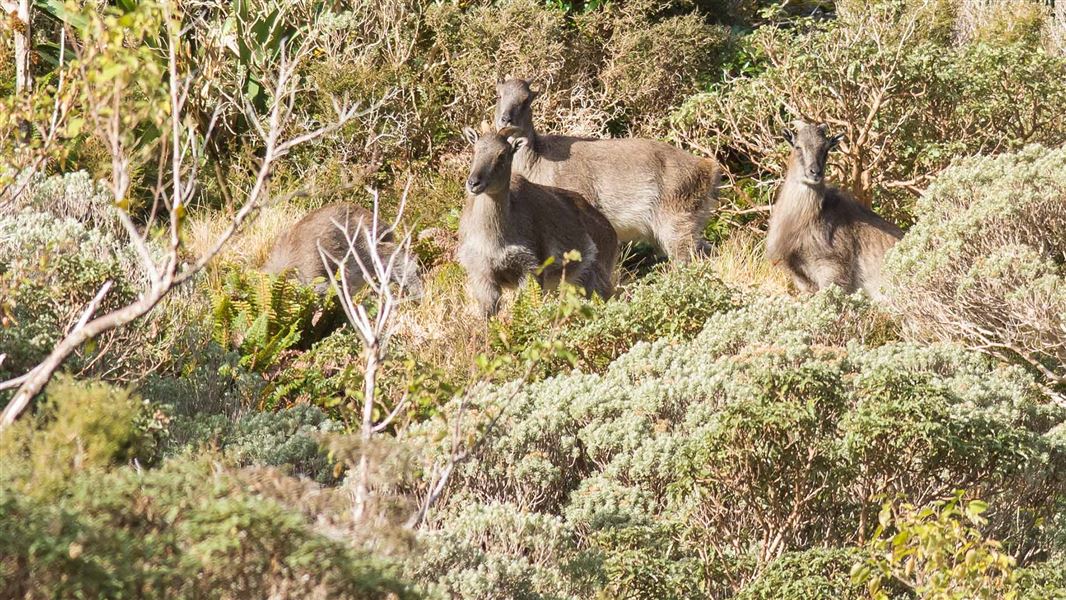Each year, we work with hunting, conservation, recreation, and land management stakeholders to produce an operational plan. We do this through the Tahr Plan Implementation Liaison Group (TPILG), which includes numerous stakeholders with an interest in tahr, including hunting, outdoor and conservation groups.
The annual plan outlines how DOC will work in partnership with various groups to control tahr and protect native ecosystems. This includes on and off public conservation land.
Operational Plan 2025/26
This plan was developed through engagement with the TPILG over approximately 5 months. Their feedback from meetings and in written submissions helped to refine this plan, which will commence on 1 July 2025 and last until 30 June 2026.
Tahr Control Operational Plan 2025/26 (PDF, 1,905K)
Updates throughout operations
As of November 2025, aerial control (including Aerial Assisted Trophy Hunting environmental offset control) is complete inside the tahr feral range until 30 June 2026. This includes in all management units.
Ground-based control will resume on the West Coast in late Summer (early 2026).
Maps showing control and identifiable male tahr locations
Maps showing where official aerial control of tahr was undertaken, and where identifiable males were spotted and left for hunters, are available on the tahr sightings and control maps page. Typically, this mapping page will be updated periodically between July and December, as official aerial control operations conclude within an area or Management Unit.
Aim of the control plan
DOC’s Tahr Control Operations are guided by the statutory Himalayan Thar Control Plan 1993. This was developed under section 5(1)(d) of the Wild Animal Control Act 1977.
The plan sets a maximum population of 10,000 tahr across 706,000 ha of private land, Crown pastoral leases and public conservation land within the tahr feral range. The feral range is the legal boundary of where tahr are allowed to be.
The 2025/26 control plan is broadly similar to recent years, as the information we have regarding tahr populations and their impacts suggests that tahr populations, while trending down, are still above the levels prescribed by the Himalayan Thar Control Plan. More information about tahr population surveys, and tahr impact monitoring can be found on the on the tahr and conservation page.
Different control approaches ‘at place’
The control plan details the work we have planned for the year. The amount and location of control effort may change if new information becomes available during the operational period. A summary of our plans for some places is available below.
Around the midpoint of the control programme DOC and the Game Animal Council will meet to review the work undertaken. Discussions from that meeting will informed management decisions made for the remainder of the plan period.
Our focus on outside the feral range and national parks
This plan focuses most effort on controlling tahr outside their feral range, with some complementary work outside management units but within the feral range, to prevent tahr spreading into new areas. Substantial effort is also allocated to tahr control in national parks and wilderness areas, to protect these special places.
Hunter-led management for South Rakaia/Rangitata (Management Unit 1)
DOC is supporting the New Zealand Tahr Foundation, with assistance from the Game Animal Council and in partnership with Te Rūnanga o Arowhenua, to develop a plan for hunter-led management of the South Rakaia/Rangitata (MU1).
The scope of hunter-led management and the activities it encompasses are still being developed but could involve hunters managing tahr populations, documenting the number of tahr controlled by hunters and reporting on the health of ecosystems. DOC is excited to see what can be achieved by working together with the group on this opportunity.
Work in other management units
Within other management units, this plan will focus most effort on places which are difficult for recreational hunters to access, but where tahr numbers and/or impacts are high.
We will not target identifiable male tahr over the 425,000 hectares of public conservation lands inside the feral range, outside national parks.
Official control of tahr conducted by aerial hunting will focus on winter and early spring to maximise control efficiency and minimise conflict with recreational users, including hunters.
In the 2025/26 year we will also use professional ground hunters and targeted management hunts conducted by hunting groups to control tahr, particularly in forest/bush areas where animals can be hard to spot from the air. These hunts will occur in spring, before the peak in kidding, and in late summer/early Autumn, before the rut.
Continued monitoring to support our planning
DOC’s research and monitoring programme is continuing this year with several initiatives underway to learn more about the tahr population and ecosystems.
We will conclude analysis of data from the remeasurement of historic vegetation plots and from a recent pilot of a more ‘rapid’ method to understand tahr impacts on vegetation condition. The results of those analyses will inform further monitoring and operational delivery, within the 2025/26 plan, and beyond. We will also commence a fresh round of monitoring on historic vegetation plots, 5 years on from the last round. These plots have historically been monitored on an approximately 10 yearly cycle but given the substantial tahr control conducted in recent years, a shorter monitoring interval is being applied to see if any vegetation recovery is evident.
More information
Previous control plans and decisions
Read previous Tahr Control Operational Plan documents and related information on control planning decisions:
Monitoring tahr populations and impacts
Find tahr hunting ‘hotspots’
DOC is mapping the locations of tahr observed on public conservation land.
Use our tahr sightings maps to plan hunts on conservation land, or find areas where you can hunt tahr and other wild animals.
